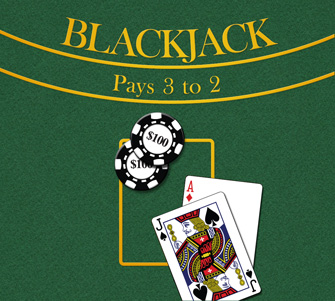Chinese Blackjack
21-Point, Ban-Nag, or Ban-Luk
How to Play Chinese Blackjack
Chinese Blackjack, also called 21-point, ban-nag (Cantonese), and ban-luck (Hokkien), is another gambling card game similar to conventional blackjack, with a few additional and more complicated rules, that is often played in South East Asia.
In Chinese Blackjack, you'll need two standard decks of 52 cards to play. The game can be played by any number of players and one dealer. The dealer can either be one set player in particular, or all players can take turns dealing every few rounds.
How to Deal Chinese Blackjack
All players begin by placing their bets. The dealer shuffles the decks of cards and has a player "cut the hand" by taking a number of cards off of the shuffled deck to be set aside. The dealer then proceeds to deal each player two cards face down and places the remaining cards back in the initial "cut hand".
How to Score Chinese Blackjack
In Chinese Blackjack, cards are scored similar to conventional blackjack, with a few small exceptions when it comes to the value of Aces. All numbered cards are worth their face value (ie a 4 is worth 4). All paint cards (Jacks, Queens, and Kings) are worth 10. To win at Chinese Blackjack, you must beat the dealer's total without going over 21.
The Ace carries a variety of values, dependent upon how many cards a player has. If a player has 2 cards, Aces can be counted as 10 or 11. If a player has 3 cards, Aces can be counted as 1 or 10. Finally, if a player has 4 or more cards, Aces are only counted as 1.
Chinese Blackjack offers a few special combinations of cards when a player is checking for blackjack. These different combinations (Ban-Ban, Ban-Nag, and 15 Points) are listed below.
Ban-Ban
If a player has two Aces, he has a ban-ban. If you get a ban-ban, you win your bet tripled by the dealer immediately, unless the dealer also receives a ban-ban (tie) or a free hand (escape hand). If a dealer receives a ban-ban, he wins all player bets tripled immediately with the same exceptions of a player having either a ban-ban or a free hand.
Ban-Nag
If a player has an Ace and either a 10, Jack, Queen, or King (a traditional blackjack), he has a ban-nag. If you get a ban-nag, you are paid double your bet by the dealer immediately, unless the dealer has a ban-ban (player loses), a ban-nag (tie), or a free hand (escape hand). In the same respect, if the dealer has a ban-nag he wins all player bets doubled immediately, unless a player has a ban-ban (player wins), ban-nag (tie), or a free hand (escape hand).
15 Points
When a player has a total of 15 points, he is said to have a free hand (escape hand). The player has the option to continue or not to continue with the hand. If a dealer receives a free hand, he has the same options as the player. If the dealer chooses not to continue, all cards are shuffled back into the deck and the hand is over.
Player's Options
After checking for blackjack and special combination cards, each player has a set of choices similar to conventional blackjack. Players have the options of hitting, to receive additional cards, and standing, to receive no more cards. Once a player stands, his hand is made. If a player receives 5 cards without busting (5-Dragon), he receives double his bet immediately from the dealer. If a player receives 5 cards that total exactly 21, he receives triple his bet immediately from the dealer.
Dealer's Options
After all players have acted, the dealer has his own set of options. If the dealer has a hand with a total less than 16, he must hit. If he has a total of 16-21, without busting, he can hit or reveal some players' hands, then hit. If he has a total of 21, all players reveal their cards. If he reaches a total over 21, he has busted and pays all players their bets at even money. If the dealer receives 5 cards without busting (5-Dragon), he receives each players bet doubled. If the dealer receives 5 cards that total exactly 21, he receives each players bet tripled.
After the dealer has settled all bets with each player, the cards are collected and a new hand begins.
More Blackjack Related Games:


 Slots Capital
Slots Capital

